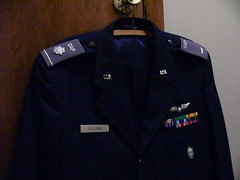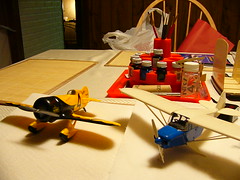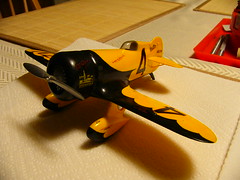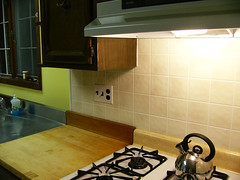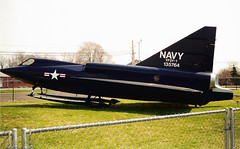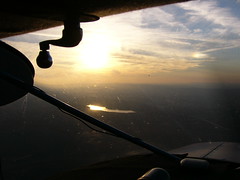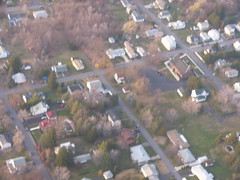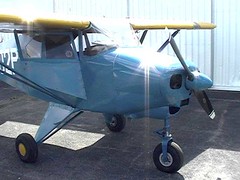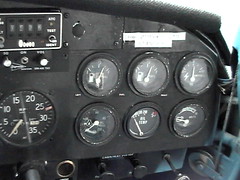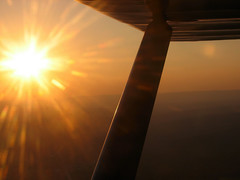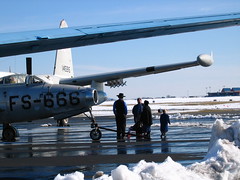It's been a busy day, lots to talk about. It began at the oncology office, where we discussed the dilemma of my health. Yesterday's bloodwork showed that my hemoglobin and platelet counts are still very low; so much so that the radiologist feels that it's too dangerous to keep me on chemo and radiation together. The X-ray from last week showed that the cancer has spread into the two long bones in my right leg, interfering with the bone marrow and causing me considerable pain.
The trouble is that we have to get my blood counts up, or I will get sicker. The radiation will lower the blood counts even further, and the chemotherapy carries its own side effects that may put me in bed too. But untreated, the cancer can (and has) spread. So we agreed that it would be better to go down fighting than to hope that the blood counts will come up on their own. So I started this afternoon on a stronger dose of another chemotherapy drug, the one I was first given after my diagnosis; it brought me a lot of nausea and other nasty side effects, but Dr. A feels that it is our best hope.
The thing is, I feel fairly well. The worst of it for the past five days has been that the bone pain has been growing somewhat, forcing me to take supplemental pain medication during the day; but with careful dosage, and taking food along with the pills, I have avoided the worst of the stomach damage.
I had a long chemotherapy session, then got typed and matched for another transfusion tomorrow; I am to get two more units of whole blood and two of platelets. All week I am also getting various injections to try and help my remaining bone marrow work overtime to manufacture some blood. Think - er - bloody thoughts everyone!
Then I just made it home in time to meet one of my squadron pilots, who drove me out to headquarters for our Civil Air Patrol meeting. My deputy commander had asked me to come out if I could manage, as they had a "special" presentation to make, and that the Wing Commander might be there. I assumed that it was my long, long deferred promotion to Captain; since rank is of little consequence in the CAP, I never really bothered to put through the paperwork, even though I could have done so years ago. I had a good five-year run as First Lieutenant, and always kidded that I never wanted to be a Major - too likely to end up on a committee, instead of in a cockpit!
It turns out that the surprise was indeed that - the Wing Commander couldn't make it, but the Group Commander called me forward and read off a list of my accolades over the last eight years; what's left of my blood managed to turn my ears a bit red for the occasion, and I blushed. He also recognized 207 as the premiere squadron in Group 4, the biggest and most well-trained unit in eastern Pennsylvania. Then he announced to the formation present that I was being given a merit promotion to the rank of Lieutenant Colonel. That's passing over Captain AND Major! As I said, rank in the CAP is largely ceremonial; since we are all unpaid volunteers, it's not like my salary is going up! But I was bowled over, and flattered, and I hardly knew what to say. I managed to stammer out a few words and thanked my squadron for their tremendous support and hard work.
It has been my pride and honor to serve my squadron since 1997, for the last nine months as Squadron Commander. I've spent hundreds of hours in training, flying, and working with a great group of officers and teenage cadets; plus I've gotten USAF travel opportunities, furthered my own flying career and been honored with a national award for education. I hope that I will soon recover my health, and become active again with the organization - and make some real trouble with these silver clusters! Thanks again to those who have made my volunteering so rewarding.
Tuesday, November 29, 2005
Hobby Time
My hands seemed to be steadier tonight, so I pulled out the model Tri-Pacer that I started a few months ago. I also unearthed another model that I found in the basement, a model racing plane that I had nearly finished from years ago - I must have set it aside sometime around 1992, when my former brother-in-law got me started with the bigger radio-controlled flying models. This poor kit only needed the last few scallops painted on its jaunty 1930s paint scheme, and a few odd parts glued on. I've dusted it off and hand-painted the last details, and with a coat of gloss enamel and a few flying wires it will be ready for the shelf.
It's a replica of the 1931 Gee Bee Model Z, a classic from the glory days of air racing. The Gee Bees (named for the New England company that built them, the Granville Brothers) were notorious for their approach to speed-seeking: maximum engine, minimum airplane. The stubby Model Z was only 15 feet long, but was bolted to a 535 h.p. "Wasp Junior" radial engine, loaned to the brothers by the Pratt & Whitney company for "testing". The combination was a handful to fly, but it was certainly fast; ex-barnstormer Lowell Bayles flew it to an easy win in the 1931 Thompson Trophy at 236 m.p.h.
But ambition seized the Granvilles and Pratt & Whitney, and the engine was changed out for an even bigger 750 h.p. Wasp Senior - in this form, Bayles could hardly see around the cowl! But an attempt was set up to try for the world speed record, 278 m.p.h., held by the French. The first set of straight-line runs averaged 281 m.p.h., good enough for the U.S. record, but not enough to better the world mark by a wide enough margin. The next time out, Bayles entered the timing run at over 300 m.p.h... but then cameras captured a gruesome sight as a wing panel snapped off, and the tiny Gee Bee rolled into the ground. Bayles and the plane were destroyed in an instant.
The Granvilles built other racers; their 1932 Model R won both the Thompson Trophy (with Jimmy Doolittle flying) and the transcontinental Bendix Trophy. But the whole family of planes were just like the Z, fast and capricious - and some less-experienced pilots were killed trying to pilot the "flying barrels" in other events. I've always been fascinated by them; the colorful scalloped paint schemes were a Granville Brothers trademark, and have come to be iconic of the whole pylon racing era. Many of these little planes were built in small hangars and garages during the Depression, with limited resources and engineering; but they contributed a lot to the advancement of aviation technology.
It's a replica of the 1931 Gee Bee Model Z, a classic from the glory days of air racing. The Gee Bees (named for the New England company that built them, the Granville Brothers) were notorious for their approach to speed-seeking: maximum engine, minimum airplane. The stubby Model Z was only 15 feet long, but was bolted to a 535 h.p. "Wasp Junior" radial engine, loaned to the brothers by the Pratt & Whitney company for "testing". The combination was a handful to fly, but it was certainly fast; ex-barnstormer Lowell Bayles flew it to an easy win in the 1931 Thompson Trophy at 236 m.p.h.
But ambition seized the Granvilles and Pratt & Whitney, and the engine was changed out for an even bigger 750 h.p. Wasp Senior - in this form, Bayles could hardly see around the cowl! But an attempt was set up to try for the world speed record, 278 m.p.h., held by the French. The first set of straight-line runs averaged 281 m.p.h., good enough for the U.S. record, but not enough to better the world mark by a wide enough margin. The next time out, Bayles entered the timing run at over 300 m.p.h... but then cameras captured a gruesome sight as a wing panel snapped off, and the tiny Gee Bee rolled into the ground. Bayles and the plane were destroyed in an instant.
The Granvilles built other racers; their 1932 Model R won both the Thompson Trophy (with Jimmy Doolittle flying) and the transcontinental Bendix Trophy. But the whole family of planes were just like the Z, fast and capricious - and some less-experienced pilots were killed trying to pilot the "flying barrels" in other events. I've always been fascinated by them; the colorful scalloped paint schemes were a Granville Brothers trademark, and have come to be iconic of the whole pylon racing era. Many of these little planes were built in small hangars and garages during the Depression, with limited resources and engineering; but they contributed a lot to the advancement of aviation technology.
Wednesday, November 23, 2005
Maple-brine Turkey
I seem to have piqued some curiosity about my Thanksgiving turkey recipe. "Brining" is simply marinating in salt water, which penetrates the meat well. This brine uses maple syrup and brown sugar; but it doesn't make the turkey salty, or overpower the flavor. It adds a subtle sweet flavor to the outer skin, and I find that it keeps the meat very moist; no dry turkey!
INGREDIENTS:
1-1/2 gallons (24 cups) water
1-1/2 cups maple syrup
1 cup salt
3/4 cup brown sugar
Mix all this up in a big stockpot at room temperature, plop in your turkey, and stick it in the 'fridge for 12-24 hours before cooking. (Discard the brine afterwards.) I use 325 degrees for three hours, for my usual 9-10 pound turkey; follow the directions for other sizes. I use a baking bag, and open it up for the last hour to crisp the skin. So far I've gotten a nice juicy bird every time.
Happy Thanksgiving!
INGREDIENTS:
1-1/2 gallons (24 cups) water
1-1/2 cups maple syrup
1 cup salt
3/4 cup brown sugar
Mix all this up in a big stockpot at room temperature, plop in your turkey, and stick it in the 'fridge for 12-24 hours before cooking. (Discard the brine afterwards.) I use 325 degrees for three hours, for my usual 9-10 pound turkey; follow the directions for other sizes. I use a baking bag, and open it up for the last hour to crisp the skin. So far I've gotten a nice juicy bird every time.
Happy Thanksgiving!
Weird Planes
Since I have a lot of time on my hands, in waiting rooms and otherwise, I've been reading a lot. I've worked through almost everything in my vast aviation and science-fiction library that I care to re-read, and so I ordered some new books for myself. I have always loved bookstores; when I was a kid, I would head straight for the bookstore, stay there for hours and grumble if I had to do any other shopping. But now it's all online - Barnes & Noble, Amazon and others all have smooth-working websites that let you browse inside the book covers a little. And there are plenty of smaller stores online too, with specialized subject matter, like Hannan's Runway - for modelers and other airplane enthusiasts.
I have two new books from Hannan's, monographs on a few obscure planes from the 1950s. It was the era when the Cold War got into full swing, and the superpowers let the military aviation budgets run wild, with some startling results. It seems as though just about any cockamamie idea was worth a few zillion dollars and a few prototypes; of course, in those days without computer simulation, that was the only way to find out whether theory could be put into practice. Aviation history of this era is dotted with faded pictures of these orphans, hilarious in hindsight to everyone but the poor test pilots - where they survived...
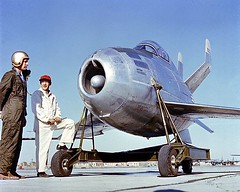 For example, jet bombers of that era had much longer range than jet fighters. But bombers are vulnerable without fighter escort. Proposal: Stick a tiny, ugly jet fighter inside the bomber. When the bomber is attacked, release it on a trapeze and let it go off to battle the Commies. Then the jet fighter returns to the bomber IN MIDAIR, latches on again, FOLDS UP and is pulled in. Insane, right? But they did it - this is the XF-85 "Goblin", built to test the "parasite fighter" concept. Its bizarre shape allowed it to fit into the bomb bay of a B-29, but left it severely limited in terms of performance and stability.
For example, jet bombers of that era had much longer range than jet fighters. But bombers are vulnerable without fighter escort. Proposal: Stick a tiny, ugly jet fighter inside the bomber. When the bomber is attacked, release it on a trapeze and let it go off to battle the Commies. Then the jet fighter returns to the bomber IN MIDAIR, latches on again, FOLDS UP and is pulled in. Insane, right? But they did it - this is the XF-85 "Goblin", built to test the "parasite fighter" concept. Its bizarre shape allowed it to fit into the bomb bay of a B-29, but left it severely limited in terms of performance and stability.
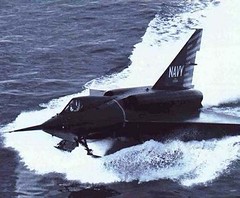 One of my new books details the Convair Sea Dart, a supersonic jet fighter... seaplane. The U.S. Navy opined that runways and air bases were expensive to build and maintain, and even Air Force pilots could land on them. So the "floating base" concept was put forward whereby bombers, cargo planes and even the fighters could land and take off on water, bobbing happily away in any harbor or lake. The Sea Dart - a twin-jet, delta-winged fighter was designed to take off and land ON WATERSKIS - insane, right? But five were built and three actually flown - and they remain, to this day, the only supersonic seaplanes ever built. (The test planes were underpowered, but one of them exceeded the speed of sound in a slight dive.)
One of my new books details the Convair Sea Dart, a supersonic jet fighter... seaplane. The U.S. Navy opined that runways and air bases were expensive to build and maintain, and even Air Force pilots could land on them. So the "floating base" concept was put forward whereby bombers, cargo planes and even the fighters could land and take off on water, bobbing happily away in any harbor or lake. The Sea Dart - a twin-jet, delta-winged fighter was designed to take off and land ON WATERSKIS - insane, right? But five were built and three actually flown - and they remain, to this day, the only supersonic seaplanes ever built. (The test planes were underpowered, but one of them exceeded the speed of sound in a slight dive.)
As you might guess, they were useless as fighter planes, and practically destroyed themselves on takeoff and landing. I have actually seen two of the surviving examples, this one on display at Willow Grove Naval Air Station near Philadelphia, the other at a museum in San Diego. (Oddly, I saw them on two consecutive days, when I flew out with the Air Force!)
Amazing, that so much money and effort was put into projects like these, with so little return on the investment. Especially in those cases, like the Sea Dart, where test pilots were killed in the flight-test program. But then, the mixture of comedy and tragedy in these machines seems appropriate for the whole Cold War, doesn't it?
I have two new books from Hannan's, monographs on a few obscure planes from the 1950s. It was the era when the Cold War got into full swing, and the superpowers let the military aviation budgets run wild, with some startling results. It seems as though just about any cockamamie idea was worth a few zillion dollars and a few prototypes; of course, in those days without computer simulation, that was the only way to find out whether theory could be put into practice. Aviation history of this era is dotted with faded pictures of these orphans, hilarious in hindsight to everyone but the poor test pilots - where they survived...


As you might guess, they were useless as fighter planes, and practically destroyed themselves on takeoff and landing. I have actually seen two of the surviving examples, this one on display at Willow Grove Naval Air Station near Philadelphia, the other at a museum in San Diego. (Oddly, I saw them on two consecutive days, when I flew out with the Air Force!)
Amazing, that so much money and effort was put into projects like these, with so little return on the investment. Especially in those cases, like the Sea Dart, where test pilots were killed in the flight-test program. But then, the mixture of comedy and tragedy in these machines seems appropriate for the whole Cold War, doesn't it?
Setbacks
After getting a few extra days off from radiation, I still tested with very low blood counts on Monday. I had my radiation treatments, but with the counts still low on Tuesday my oncologist decided to postpone my chemotherapy. The problem is that the radiation and chemotherapy both affect my bone marrow, so that it doesn't produce the right blood cells - but the cancer itself is also having the same effect. Some new painful areas, and the evidence of the blood count, indicate that the cancer is working on my bone marrow too.
Oddly, I don't feel that much worse than I have been for the last month. I still have to take painkillers around the clock, and I've had terrible digestive tract problems; but my appetite and energy have been reasonably consistent. But on Monday they asked me to report in immediately if I experienced any fevers (because I have few white blood cells to fight infections) or bleeding (because I have few platelets to coagulate my blood). Well, lo and behold Tuesday morning I developed a spontaneous nosebleed, and Gail took me in early to Dr. A's office. He discussed the predicament that we're in; do we press harder with chemotherapy and radiation, which may leave me bedridden, or back off and risk further damage from the cancer? It's a balancing act between quality of life and quantity, only now with a narrower margin than we have had so far.
So the plan for the coming week is to continue my radiation treatments Wednesday, since I am almost done with the neck-shoulder series, and there is little marrow in those bones anyway. We will delay the next chemotherapy until Tuesday, when we will go back to another medication, one that may be more effective and be less traumatic for the bone marrow. Plus we may be able to use some of the newer drugs to offset the effects of the chemo. Today I had an X-ray on my right leg, which has been a major source of new pain.
The immediate problem of the anemia was addressed with a blood transfusion today, platelets and hemoglobin, to protect me for the short-term. I still feel OK; I ate a full lunch and dinner, and got some sleep while in the oncology lab at Moses Taylor Hospital. (I've been going to Mercy, but they couldn't accommodate me today, so Gail and I got to visit the third major hospital in town.) The verdict: Moses Taylor's food is better than Mercy, not as good as CMC. But it's a big hospital, and parts of it are very impressive; obviously some major renovations were done, but some of the working spaces are still unreconstructed. The staff were all quite friendly, though.
Hopefully my blood count will rally a little this week, and I will get to cook and enjoy my traditional maple-brine turkey for Thanksgiving. As I've written, I've been able to enjoy a reasonable quality of life for the past month or so; I hate the idea of getting sicker and ending up in bed, and/or back in the hospital. All good thoughts are welcome; have a good holiday weekend!
Oddly, I don't feel that much worse than I have been for the last month. I still have to take painkillers around the clock, and I've had terrible digestive tract problems; but my appetite and energy have been reasonably consistent. But on Monday they asked me to report in immediately if I experienced any fevers (because I have few white blood cells to fight infections) or bleeding (because I have few platelets to coagulate my blood). Well, lo and behold Tuesday morning I developed a spontaneous nosebleed, and Gail took me in early to Dr. A's office. He discussed the predicament that we're in; do we press harder with chemotherapy and radiation, which may leave me bedridden, or back off and risk further damage from the cancer? It's a balancing act between quality of life and quantity, only now with a narrower margin than we have had so far.
So the plan for the coming week is to continue my radiation treatments Wednesday, since I am almost done with the neck-shoulder series, and there is little marrow in those bones anyway. We will delay the next chemotherapy until Tuesday, when we will go back to another medication, one that may be more effective and be less traumatic for the bone marrow. Plus we may be able to use some of the newer drugs to offset the effects of the chemo. Today I had an X-ray on my right leg, which has been a major source of new pain.
The immediate problem of the anemia was addressed with a blood transfusion today, platelets and hemoglobin, to protect me for the short-term. I still feel OK; I ate a full lunch and dinner, and got some sleep while in the oncology lab at Moses Taylor Hospital. (I've been going to Mercy, but they couldn't accommodate me today, so Gail and I got to visit the third major hospital in town.) The verdict: Moses Taylor's food is better than Mercy, not as good as CMC. But it's a big hospital, and parts of it are very impressive; obviously some major renovations were done, but some of the working spaces are still unreconstructed. The staff were all quite friendly, though.
Hopefully my blood count will rally a little this week, and I will get to cook and enjoy my traditional maple-brine turkey for Thanksgiving. As I've written, I've been able to enjoy a reasonable quality of life for the past month or so; I hate the idea of getting sicker and ending up in bed, and/or back in the hospital. All good thoughts are welcome; have a good holiday weekend!
Sunday, November 20, 2005
Some amazing videos
Gail has our flying video from today uploaded to YouTube.com, a very slick video-sharing site. She has been putting together short clips from her digital camera, and adding more editing and her own soundtracks. It's neat for me to be able to watch afterwards, since I'm often busy as we fly (!) and I can rate my takeoff and landing technique.
There are other interesting flying clips, too. Here is one that must have been professionally edited, posted by a military fighter pilot:
Speaking of landing technique - in just a few minutes of browsing I came up with this frightening capture. (Apparently a British Airways flight - shudder to think of the poor passengers!)
Anyway, I'm going back to browse some more; I found these in just a few minutes! You can find Gail's other videos here.
There are other interesting flying clips, too. Here is one that must have been professionally edited, posted by a military fighter pilot:
Speaking of landing technique - in just a few minutes of browsing I came up with this frightening capture. (Apparently a British Airways flight - shudder to think of the poor passengers!)
Anyway, I'm going back to browse some more; I found these in just a few minutes! You can find Gail's other videos here.
Saturday, November 19, 2005
Up there again
It was beautiful here today, clear but cold, so Gail and I took off for another airplane ride. I was not feeling too sore, just a little uneven in the gastric department; so I figured I would go up and see how long I could do without a bathroom. Quite a while, as it turned out - fortunately, because Fielding Airlines does not offer lavatory facilities on any of its aircraft. (We pass the savings along to you.)
I took us for a long, clockwise circle around the valley, first heading into the big airport at Scranton for a touch-and-go landing. (As I flew down the runway, I wondered whether any of the airline travelers took notice of our little plane buzzing alongside. If they did, I guess they knew they weren't exactly at JFK...)
On the way in, we passed right over Lake Scranton and our little landlocked neighbourhood, and Gail took some good photos that she's posting now. (Some movies are in the works, too.) Then over the river to the Wyoming Valley airport, a little anachronism that hasn't changed since the 1940s. I landed on the paved runway and taxied over to assess the condition of the grass strip; it's smooth, but we've had some rain lately, and I decided against some soft-field practice - it's too cold to stand outside cleaning mud off the poor Tri-Pacer. Instead we took off again and flew across the north ridge, the "Back Mountain" area, and east back to Cherry Ridge. At this point I put us into a long glide at a higher power setting, as I was starting to want that bathroom; I was grateful for a slight tailwind that pushed us up to around 150 m.p.h. over the ground.
Landed just in time, and had a nice ride back as the sun set, and Gail fixed a supper that couldn't be beat; so, I'm happy to log another very good Saturday. Hope yours was as well.
I took us for a long, clockwise circle around the valley, first heading into the big airport at Scranton for a touch-and-go landing. (As I flew down the runway, I wondered whether any of the airline travelers took notice of our little plane buzzing alongside. If they did, I guess they knew they weren't exactly at JFK...)
On the way in, we passed right over Lake Scranton and our little landlocked neighbourhood, and Gail took some good photos that she's posting now. (Some movies are in the works, too.) Then over the river to the Wyoming Valley airport, a little anachronism that hasn't changed since the 1940s. I landed on the paved runway and taxied over to assess the condition of the grass strip; it's smooth, but we've had some rain lately, and I decided against some soft-field practice - it's too cold to stand outside cleaning mud off the poor Tri-Pacer. Instead we took off again and flew across the north ridge, the "Back Mountain" area, and east back to Cherry Ridge. At this point I put us into a long glide at a higher power setting, as I was starting to want that bathroom; I was grateful for a slight tailwind that pushed us up to around 150 m.p.h. over the ground.
Landed just in time, and had a nice ride back as the sun set, and Gail fixed a supper that couldn't be beat; so, I'm happy to log another very good Saturday. Hope yours was as well.
Friday, November 18, 2005
The Waiting Game
Gail just wrote a very funny post about the many waiting rooms that she endures while I'm in my various treatments. I've been healthy enough to avoid hospitals most of my life until now, so my limited experience with the medical world has been a few stays in those same waiting rooms; and I know how awful they can be, since you may be dealing with the stress and worry about your particular patient. I can't thank her enough for going through all this with me, and keeping her sense of humour.
I thought I would add a few words about what lies beyond... since, in many of these places, there are layers of waiting rooms and recovery areas that Gail doesn't get to "enjoy" with me. I'll go along with her choice of the NROC as the best, even though I'm not a coffee fan (I know she loves the free, modern latte machine!) There, we wait together until it's my time to board "The Machine", and then I go straight to the table. My latest round of treatments include a very tight shot at my neck, so they have been strapping my head down; somewhat unpleasant, but usually over in ten minutes or so.
When I go for my chemotherapy, once a week now, there are several phases to my visit. We start off waiting together in the outer room of the Hematology and Oncology Clinic, which is devoid of magazines - only plenty of materials about cancer, smoking, medications and the like. You know what? By this point, I've read everything I care to about cancer; even Field and Stream would be better. But I usually get called out of this one quickly, and off to a row of phlebotomy "cubicles" where my eternally bruised veins are punctured for a blood test. After this I shuffle over to the next waiting area, which is well-stocked with magazines, including a few issues of my fave - National Geographic. (It's like a glossy little PBS to read!) Next comes the exam, usually by my main oncologist but occasionally an assistant. I'm impressed by how computer-integrated this process is; all of the medical staff carry laptops, wireless networked, and my whole medical history is available on them - even the current day's blood counts pop up, as soon as the lab processes them. The laptop displays not only the dry facts and medications, but all of the scans and imagery in full color, going back to my initial diagnosis!
Then I get walked into the chemotherapy room, a vast half-circle divided into rooms around the perimeter by half-height walls; each room is further divided into four cubicles, each with a reclining chair and individual television. The cubicles on the outer bank have broad windows, looking out on a dull view of a grassy embankment, but at least it's natural light. All in all, it's a fairly friendly place, but the careful planning falls apart in a few ways: First, although every cubicle has a television set, they DON'T have headphones... so that many of the chemo patients switch on, choose a station, and then begin the Volume Wars. To hear one show above your neighbor - who is just a few feet away, behind a half-height partition - you naturally have to turn it up a bit. Remember that most of my fellow patients are well-advanced in age to begin with, and you get an idea of the din in there on a busy day! Lately, the crowds have been light, and due to a technical problem the satellite TV boxes are not working; so everyone has to watch the same show, if they do at all. Better for me, since I never watch anyway, preferring to read or doze while I drip-feed. (Last week, though, I had to endure sitting next to a patient with an older woman companion - one who told long, pointless stories - in a loud, squeaky voice. Maybe I should carry some emergency headphones, just in case.)
Here I sit for usually about two hours, with a big needle in my arm and a blanket on my lap. (It's always too cold, whether my blood is thin or not.) Despite getting chemo every week, my arm veins are holding out, so I haven't heard any more talk about putting in a semi-permanent port in my chest. I don't mind the needles, most of the techs are skilled and set me to dripping without much discomfort. Gail doesn't have to wait for all these hours, our home is just five minutes away; or she can go off to do shopping or other errands. Lately my appointments are timed so that I finish chemo in time to walk through the corridor from the HOC to the NROC and get irradiated, and Gail meets me there.
I should also mention what goes on when I go to Mercy Hospital for any of my various MRI scans, since it's quite different on "the inside". Gail mentioned the MRI waiting area, and it is at least well-decorated - but when I go in, the scene is dramatically different. The trip is a long one, down many stark grey hallways to reach the MRI room; if I am sore that week, one of the techs will wheel me in a chair. (It's not unlike the opening credits in the classic spy sitcom Get Smart.) The MRI lab at Mercy is an all-male zone, and it shows; the guys who do the scans set me up with headphones and ask me what radio station I prefer; classic rock is the default. They are a casual, friendly bunch - one of them is married to one of my radiology techs - and all speak with rich Scranton accents. But for all the rough edges, they are a good crew; they take pains to make me comfortable, which can be difficult depending on my condition. I'm not claustrophobic, but the beige-steel tunnel is small, barely bigger than I am; and sometimes I have to spend 45 minutes or more inside. Often I am sore, and the platform is hard on my back; they try to pad me as best they can. Once I was overcome by nausea between scans, and had to be let out to lose my breakfast. At least I've learned to put my wallet in the locker - didja know that MRI machines will erase all of the magnetic strips on your credit cards? Whoops...
Anyway, a quick recap: I am currently getting a few days off from radiation due to a low platelet count. My shoulder and neck are much better, and my sore throat will be glad for the break; but my left hip is still quite sore. I just started those treatments. I have a good supply of my various pain meds, and I've sorted out the doses to control my overall level of pain, for the most part. I have, at my discretion, several narcotic painkillers and a steroid to use for pain; but none of them are perfect, and to be honest none of them make me feel good; the best I hope for is basic relief. I have many other pills to relieve other symptoms, mostly from the side-effects of chemo, radiation... and all the other pills. If I take too many of any of them, my stomach gets torn up, and other gastric troubles ensue, so I have been trying for minimalism.
Anyway, if you've made it this far, thanks for reading... hope it hasn't been too much of a wait.
I thought I would add a few words about what lies beyond... since, in many of these places, there are layers of waiting rooms and recovery areas that Gail doesn't get to "enjoy" with me. I'll go along with her choice of the NROC as the best, even though I'm not a coffee fan (I know she loves the free, modern latte machine!) There, we wait together until it's my time to board "The Machine", and then I go straight to the table. My latest round of treatments include a very tight shot at my neck, so they have been strapping my head down; somewhat unpleasant, but usually over in ten minutes or so.
When I go for my chemotherapy, once a week now, there are several phases to my visit. We start off waiting together in the outer room of the Hematology and Oncology Clinic, which is devoid of magazines - only plenty of materials about cancer, smoking, medications and the like. You know what? By this point, I've read everything I care to about cancer; even Field and Stream would be better. But I usually get called out of this one quickly, and off to a row of phlebotomy "cubicles" where my eternally bruised veins are punctured for a blood test. After this I shuffle over to the next waiting area, which is well-stocked with magazines, including a few issues of my fave - National Geographic. (It's like a glossy little PBS to read!) Next comes the exam, usually by my main oncologist but occasionally an assistant. I'm impressed by how computer-integrated this process is; all of the medical staff carry laptops, wireless networked, and my whole medical history is available on them - even the current day's blood counts pop up, as soon as the lab processes them. The laptop displays not only the dry facts and medications, but all of the scans and imagery in full color, going back to my initial diagnosis!
Then I get walked into the chemotherapy room, a vast half-circle divided into rooms around the perimeter by half-height walls; each room is further divided into four cubicles, each with a reclining chair and individual television. The cubicles on the outer bank have broad windows, looking out on a dull view of a grassy embankment, but at least it's natural light. All in all, it's a fairly friendly place, but the careful planning falls apart in a few ways: First, although every cubicle has a television set, they DON'T have headphones... so that many of the chemo patients switch on, choose a station, and then begin the Volume Wars. To hear one show above your neighbor - who is just a few feet away, behind a half-height partition - you naturally have to turn it up a bit. Remember that most of my fellow patients are well-advanced in age to begin with, and you get an idea of the din in there on a busy day! Lately, the crowds have been light, and due to a technical problem the satellite TV boxes are not working; so everyone has to watch the same show, if they do at all. Better for me, since I never watch anyway, preferring to read or doze while I drip-feed. (Last week, though, I had to endure sitting next to a patient with an older woman companion - one who told long, pointless stories - in a loud, squeaky voice. Maybe I should carry some emergency headphones, just in case.)
Here I sit for usually about two hours, with a big needle in my arm and a blanket on my lap. (It's always too cold, whether my blood is thin or not.) Despite getting chemo every week, my arm veins are holding out, so I haven't heard any more talk about putting in a semi-permanent port in my chest. I don't mind the needles, most of the techs are skilled and set me to dripping without much discomfort. Gail doesn't have to wait for all these hours, our home is just five minutes away; or she can go off to do shopping or other errands. Lately my appointments are timed so that I finish chemo in time to walk through the corridor from the HOC to the NROC and get irradiated, and Gail meets me there.
I should also mention what goes on when I go to Mercy Hospital for any of my various MRI scans, since it's quite different on "the inside". Gail mentioned the MRI waiting area, and it is at least well-decorated - but when I go in, the scene is dramatically different. The trip is a long one, down many stark grey hallways to reach the MRI room; if I am sore that week, one of the techs will wheel me in a chair. (It's not unlike the opening credits in the classic spy sitcom Get Smart.) The MRI lab at Mercy is an all-male zone, and it shows; the guys who do the scans set me up with headphones and ask me what radio station I prefer; classic rock is the default. They are a casual, friendly bunch - one of them is married to one of my radiology techs - and all speak with rich Scranton accents. But for all the rough edges, they are a good crew; they take pains to make me comfortable, which can be difficult depending on my condition. I'm not claustrophobic, but the beige-steel tunnel is small, barely bigger than I am; and sometimes I have to spend 45 minutes or more inside. Often I am sore, and the platform is hard on my back; they try to pad me as best they can. Once I was overcome by nausea between scans, and had to be let out to lose my breakfast. At least I've learned to put my wallet in the locker - didja know that MRI machines will erase all of the magnetic strips on your credit cards? Whoops...
Anyway, a quick recap: I am currently getting a few days off from radiation due to a low platelet count. My shoulder and neck are much better, and my sore throat will be glad for the break; but my left hip is still quite sore. I just started those treatments. I have a good supply of my various pain meds, and I've sorted out the doses to control my overall level of pain, for the most part. I have, at my discretion, several narcotic painkillers and a steroid to use for pain; but none of them are perfect, and to be honest none of them make me feel good; the best I hope for is basic relief. I have many other pills to relieve other symptoms, mostly from the side-effects of chemo, radiation... and all the other pills. If I take too many of any of them, my stomach gets torn up, and other gastric troubles ensue, so I have been trying for minimalism.
Anyway, if you've made it this far, thanks for reading... hope it hasn't been too much of a wait.
Sunday, November 13, 2005
Clarification
I should mention that the food poisoning incident mentioned in the last post was self-induced. Gail always does a good job of feeding me, and steering me away from the Bad Things that I normally eat on my own. But last week I slipped in a delicacy I found in the freezer section, "Cohen's Egg Rolls" - right there you can spot trouble - and I found them a little bland, so I dipped them in some rather antiquated condiments I had put in the 'fridge sometime around the first Gulf War.
By the next day, I knew that something had gone awry. No details will be forthcoming, but I was very sick for the next three days. The lessons, of course, are: 1) Jews probably shouldn't make egg rolls. 2) Clean out the refigerator now and then, and 3) Listen to Gail.
By the next day, I knew that something had gone awry. No details will be forthcoming, but I was very sick for the next three days. The lessons, of course, are: 1) Jews probably shouldn't make egg rolls. 2) Clean out the refigerator now and then, and 3) Listen to Gail.
Saturday, November 12, 2005
The Saga of 02P, Part III
First, the obligatory progress report: I haven't been up and around much for the last few days. Not because of radiation, chemotherapy and cancer, which are all ongoing; but due to a touch of food poisoning, apparently. I will not go into detail because - well, the details are gross. But I'm just starting to feel better, and I think I can sit upright and write for a spell. So on to the next installment of how I bought my plane...
OK, when we last heard, I had bought a one-way ticket to Nashville, Tennessee. The Tri-Pacer I was going to see, N1502P, was based right there at Nashville International. I had only to fly in and meet the seller; if the plane and the deal were satisfactory, I could just fly it home. I had taken the trouble to make this feasible, by arranging financing and insurance ahead of time, all contingent on a pre-purchase inspection. It made things complicated, but I didn't want to have to travel back and forth twice if everything went well.
I had planned on going down alone, but a few days before the trip I was surprised to have a volunteer co-pilot; my friend Karen, an airline pilot herself, wanted to come along. When she heard about my plans, she figured it sounded like a good adventure - she had never flown a fabric-covered airplane before, and she could easily deadhead* down to meet me in Nashville. I warned her: "It's very small, you know... and very slow; it will take around eight hours to fly back, and there's no air conditioning..." But she couldn't be swayed, and I was actually glad to have the company for the trip back, if it came to that.
So on the appointed Friday, I left after work and flew down on the evening flight from Scranton to Nashville. I discovered that anyone traveling on a one-way ticket gets the extra-thorough bag and personal search, so I ran out to the commuter jet cramming my belongings back into my flight bag; I was trying to travel light. I landed in Nashville on a sweltering hot August evening, and got a cab from the terminal to the general aviation ramp (the "F.B.O.") where I planned to spend the night in the pilot's lounge and meet the seller in the morning. I was the only one around, apart from a bored line service guy, and he showed me to the lounge. I was initially happy to note that the the lounge was comfortably appointed and well air-conditioned; in fact, it was downright arctic, as is often the case in the South. Since I only had the t-shirt I was wearing, and one other for the next day, I spent the night alternating between the freezing lounge and the bench outside, where even at 3:30 am it was almost 90 F.
The next morning, having hardly slept, I took a courtesy car for breakfast and eventually met up with Karen and the seller. He drove us out to the hangar, where he had a rather lavish setup for keeping such a tiny plane; climate-controlled, with a separate office and plenty of tools and extra gear. (He was selling the little Tri-Pacer to trade up to a larger plane, one which he could use to fly his whole family of four around in speed and comfort.) I grinned on seeing the plane; you can't help it, with the jaunty paint scheme it wears. The previous owner, an older fellow, had chosen the bright 1930s Army Air Corps scheme (purely for fun; no Tri-Pacer was ever used by the U.S. military). I climbed all over the plane and did my best to assess the condition; it all looked to be in good order and as described.
The first order of business was a test flight, so Karen waited while the seller and I climbed in and taxied out for a short ride. It took a long time to reach the runway and get clearance; Nashville is a BIG airport. By this time, the temperature had climbed over 90 again, and when I advanced the throttle, I was not overwhelmed by the ensuing takeoff and climbout. I had expected less performance, since this Tri-Pacer was equipped with an older 135 horsepower engine. But the high temperature and humidity really took a toll; it took a long time to climb to just 1,000 feet and head west of the airport.
I enjoyed flying the plane, though, and did some takeoffs and landings at a smaller airport nearby. Back at Nashville, we stepped into the office and talked over the deal. He ended up coming down on the price, and throwing in quite a bit of extra gear and parts, including his yoke-mounted GPS unit. I shook his hand and signed on the dotted line - and I owned an airplane! Now, to get home...
First problem: packing! There was Karen and myself, and our bags... and a large box containing a set of canvas plane covers, and another with parts and gauges, some cans of spare paint... and finally, a set of Short Wing Piper Club books and magazines that must have weighed 50 pounds. The plane has four seats, and a roomy baggage compartment; but there is a limit to how much weight can be carried, and we were going to be over - and on a hot, humid day to boot. So I prevailed on the seller to do me one more favor, and ship the heaviest items to my address, so that we would have a fighting chance of getting off the ground!
Karen and I folded ourselves into 02P - my plane! - and taxied out again to the active runway. We chugged away, crawling compared to the jumbo jets arriving and departing around us, and headed north into the thick summer haze. From the start it was apparent that we were in for a long trip; we noticed that if we tried to run at 75% power, the oil temperature would keep climbing to the high side of the gauge. The only way to hold the temp steady was to run at lower power, and that barely yielded 90 knots; I had planned our 700-mile trip at 105, so it was going to take a little longer.
Worried about the engine temps, I stopped at Somerset, Kentucky to check the oil. As we hopped out, I saw that there was at least a quart streaked across the belly; the overheated oil had pumped overboard through the bearings for the vacuum pump. So we bought a few quarts, added some to the crankcase and took off again, resolved not to run the engine hard. By the time we reached Richmond we had to stop again to add more oil, and we realized that with our slow progress and extra stops, we weren't going to make it home that day. We pressed on as far as Parkersburg, West Virginia where the setting sun and lowering clouds convinced us to spend the night.
Well, this installment has gone long enough. Tune in again for part IV - cheap hotel rooms, bad weather and close blimp encounters!
* "Deadheading" is a free ride to reposition airline flight crews, in a spare seat on their own or another airline's flight, as an industry courtesy.
OK, when we last heard, I had bought a one-way ticket to Nashville, Tennessee. The Tri-Pacer I was going to see, N1502P, was based right there at Nashville International. I had only to fly in and meet the seller; if the plane and the deal were satisfactory, I could just fly it home. I had taken the trouble to make this feasible, by arranging financing and insurance ahead of time, all contingent on a pre-purchase inspection. It made things complicated, but I didn't want to have to travel back and forth twice if everything went well.
I had planned on going down alone, but a few days before the trip I was surprised to have a volunteer co-pilot; my friend Karen, an airline pilot herself, wanted to come along. When she heard about my plans, she figured it sounded like a good adventure - she had never flown a fabric-covered airplane before, and she could easily deadhead* down to meet me in Nashville. I warned her: "It's very small, you know... and very slow; it will take around eight hours to fly back, and there's no air conditioning..." But she couldn't be swayed, and I was actually glad to have the company for the trip back, if it came to that.
So on the appointed Friday, I left after work and flew down on the evening flight from Scranton to Nashville. I discovered that anyone traveling on a one-way ticket gets the extra-thorough bag and personal search, so I ran out to the commuter jet cramming my belongings back into my flight bag; I was trying to travel light. I landed in Nashville on a sweltering hot August evening, and got a cab from the terminal to the general aviation ramp (the "F.B.O.") where I planned to spend the night in the pilot's lounge and meet the seller in the morning. I was the only one around, apart from a bored line service guy, and he showed me to the lounge. I was initially happy to note that the the lounge was comfortably appointed and well air-conditioned; in fact, it was downright arctic, as is often the case in the South. Since I only had the t-shirt I was wearing, and one other for the next day, I spent the night alternating between the freezing lounge and the bench outside, where even at 3:30 am it was almost 90 F.
The next morning, having hardly slept, I took a courtesy car for breakfast and eventually met up with Karen and the seller. He drove us out to the hangar, where he had a rather lavish setup for keeping such a tiny plane; climate-controlled, with a separate office and plenty of tools and extra gear. (He was selling the little Tri-Pacer to trade up to a larger plane, one which he could use to fly his whole family of four around in speed and comfort.) I grinned on seeing the plane; you can't help it, with the jaunty paint scheme it wears. The previous owner, an older fellow, had chosen the bright 1930s Army Air Corps scheme (purely for fun; no Tri-Pacer was ever used by the U.S. military). I climbed all over the plane and did my best to assess the condition; it all looked to be in good order and as described.
The first order of business was a test flight, so Karen waited while the seller and I climbed in and taxied out for a short ride. It took a long time to reach the runway and get clearance; Nashville is a BIG airport. By this time, the temperature had climbed over 90 again, and when I advanced the throttle, I was not overwhelmed by the ensuing takeoff and climbout. I had expected less performance, since this Tri-Pacer was equipped with an older 135 horsepower engine. But the high temperature and humidity really took a toll; it took a long time to climb to just 1,000 feet and head west of the airport.
I enjoyed flying the plane, though, and did some takeoffs and landings at a smaller airport nearby. Back at Nashville, we stepped into the office and talked over the deal. He ended up coming down on the price, and throwing in quite a bit of extra gear and parts, including his yoke-mounted GPS unit. I shook his hand and signed on the dotted line - and I owned an airplane! Now, to get home...
First problem: packing! There was Karen and myself, and our bags... and a large box containing a set of canvas plane covers, and another with parts and gauges, some cans of spare paint... and finally, a set of Short Wing Piper Club books and magazines that must have weighed 50 pounds. The plane has four seats, and a roomy baggage compartment; but there is a limit to how much weight can be carried, and we were going to be over - and on a hot, humid day to boot. So I prevailed on the seller to do me one more favor, and ship the heaviest items to my address, so that we would have a fighting chance of getting off the ground!
Karen and I folded ourselves into 02P - my plane! - and taxied out again to the active runway. We chugged away, crawling compared to the jumbo jets arriving and departing around us, and headed north into the thick summer haze. From the start it was apparent that we were in for a long trip; we noticed that if we tried to run at 75% power, the oil temperature would keep climbing to the high side of the gauge. The only way to hold the temp steady was to run at lower power, and that barely yielded 90 knots; I had planned our 700-mile trip at 105, so it was going to take a little longer.
Worried about the engine temps, I stopped at Somerset, Kentucky to check the oil. As we hopped out, I saw that there was at least a quart streaked across the belly; the overheated oil had pumped overboard through the bearings for the vacuum pump. So we bought a few quarts, added some to the crankcase and took off again, resolved not to run the engine hard. By the time we reached Richmond we had to stop again to add more oil, and we realized that with our slow progress and extra stops, we weren't going to make it home that day. We pressed on as far as Parkersburg, West Virginia where the setting sun and lowering clouds convinced us to spend the night.
Well, this installment has gone long enough. Tune in again for part IV - cheap hotel rooms, bad weather and close blimp encounters!
* "Deadheading" is a free ride to reposition airline flight crews, in a spare seat on their own or another airline's flight, as an industry courtesy.
Sunday, November 06, 2005
Spectacular Saturday
I've been coping remarkably well with my cancer for the last two weeks or so, despite being back in chemotherapy and radiation. I still have pain (and other secondary symptoms) but my constitution and appetite have been, in general, much better.
But my planets must have been aligned extra-well today, or something; I had a wonderful day. Gail and I slept in, she catching up on her sleep after a rushed visit to New York (and I had stayed up late watching airplane movies!) I came downstairs this morning to a stunningly warm and sunny November day, and began to wonder how to make the best of it. (Hugh suggested an outing on the front porch, but surprisingly didn't stay out long.)
When Gail came bouncing down shortly afterwards, she already had an idea: to go out to Cherry Ridge airport, where we always find something to enjoy, whether it's photography, food or just my flying friends. As we drove out to the rural airstrip, I assessed myself and decided that I was in rather good shape to fly - I hadn't taken any strong painkillers, and it was last Tuesday that I last had chemo, and I was feeling strong and clearheaded. And moreover, the weather conditions were just perfect. Clear skies, light wind and shirtsleeve temperature; too good to pass up!
So on arriving at the airport, I suggested that we go straight to the hangar. Gail insisted on doing the heavy work of pulling the plane out of the hangar, to avoid straining my back, and I took my time preflighting the plane. As we taxied out there were a few other planes about (mostly students I think) but then I noticed two of my CAP comrades refueling our squadron's plane at the self-service pump. With a wave (and a snap of the shutter, of course) we took the runway.
Our little plane accelerated down the centerline as smooth as ever, and we eased into a sunny sky. It felt great to be at the controls again, as it's been over a month since I've flown; and longer than that since I've felt so lucid and strong. (I wouldn't have risked a flight, of course, if I hadn't felt sure of myself.) I circled and checked over the plane while Gail worked her cameras, and we flew south towards the lake. I was grinning, enjoying myself; I startled Gail a little when I began banking left and right, rolling in and out of the steep turns that are so much fun in our plane. Once she knew that it was deliberate, she was laughing too, and we took in the sunset over the long lake. Then I flew north up the ridgeline, onto the sunny side of a long farm of wind-driven generators; Gail got several great pictures, including this one. (She has many more to post yet.)
Then back to the airport, where I set up for one touch-and-go landing, as some of the other pleasure flyers watched from the taxiway; I got a "10" for my first effort on the radio from Mr. Tibor. Once more around the pattern and I brought us to a nice slow landing, taxied to the pumps and shut down. My CAP buddies were still around and chatted with Gail and I as we filled 02P's wing tanks, and then followed us to my hangar to help put the plane away; great chaps, those guys.
After a few minutes of hangar talk with them (and Mr. Tibor, who had come taxiing up to be social) dusk was gathering, and Gail and I were by now quite hungry. So we went back into town and stopped at Calabria's, the place to get the absolute best (and biggest) cheese calzone in the valley. I wasn't sure how hungry I was, but it turned out to be a lot, and I devoured my half of the cheesy, kayak-shaped Italian fare. Oh, that sauce... that incredible Calabria's sauce!
And - to finish off a day that couldn't be beat, at home I found out that Penn State had won again today; 35 to 14 over Wisconsin, the highest-scoring team in the Big 10, and making us 9-1 for the season. Let's Go State!
So, a good-news day all around. I've awoken from a deep, ricotta-induced sleep, and thought I would document my day, and wish you all a great one as well.
But my planets must have been aligned extra-well today, or something; I had a wonderful day. Gail and I slept in, she catching up on her sleep after a rushed visit to New York (and I had stayed up late watching airplane movies!) I came downstairs this morning to a stunningly warm and sunny November day, and began to wonder how to make the best of it. (Hugh suggested an outing on the front porch, but surprisingly didn't stay out long.)
When Gail came bouncing down shortly afterwards, she already had an idea: to go out to Cherry Ridge airport, where we always find something to enjoy, whether it's photography, food or just my flying friends. As we drove out to the rural airstrip, I assessed myself and decided that I was in rather good shape to fly - I hadn't taken any strong painkillers, and it was last Tuesday that I last had chemo, and I was feeling strong and clearheaded. And moreover, the weather conditions were just perfect. Clear skies, light wind and shirtsleeve temperature; too good to pass up!
So on arriving at the airport, I suggested that we go straight to the hangar. Gail insisted on doing the heavy work of pulling the plane out of the hangar, to avoid straining my back, and I took my time preflighting the plane. As we taxied out there were a few other planes about (mostly students I think) but then I noticed two of my CAP comrades refueling our squadron's plane at the self-service pump. With a wave (and a snap of the shutter, of course) we took the runway.
Our little plane accelerated down the centerline as smooth as ever, and we eased into a sunny sky. It felt great to be at the controls again, as it's been over a month since I've flown; and longer than that since I've felt so lucid and strong. (I wouldn't have risked a flight, of course, if I hadn't felt sure of myself.) I circled and checked over the plane while Gail worked her cameras, and we flew south towards the lake. I was grinning, enjoying myself; I startled Gail a little when I began banking left and right, rolling in and out of the steep turns that are so much fun in our plane. Once she knew that it was deliberate, she was laughing too, and we took in the sunset over the long lake. Then I flew north up the ridgeline, onto the sunny side of a long farm of wind-driven generators; Gail got several great pictures, including this one. (She has many more to post yet.)
Then back to the airport, where I set up for one touch-and-go landing, as some of the other pleasure flyers watched from the taxiway; I got a "10" for my first effort on the radio from Mr. Tibor. Once more around the pattern and I brought us to a nice slow landing, taxied to the pumps and shut down. My CAP buddies were still around and chatted with Gail and I as we filled 02P's wing tanks, and then followed us to my hangar to help put the plane away; great chaps, those guys.
After a few minutes of hangar talk with them (and Mr. Tibor, who had come taxiing up to be social) dusk was gathering, and Gail and I were by now quite hungry. So we went back into town and stopped at Calabria's, the place to get the absolute best (and biggest) cheese calzone in the valley. I wasn't sure how hungry I was, but it turned out to be a lot, and I devoured my half of the cheesy, kayak-shaped Italian fare. Oh, that sauce... that incredible Calabria's sauce!
And - to finish off a day that couldn't be beat, at home I found out that Penn State had won again today; 35 to 14 over Wisconsin, the highest-scoring team in the Big 10, and making us 9-1 for the season. Let's Go State!
So, a good-news day all around. I've awoken from a deep, ricotta-induced sleep, and thought I would document my day, and wish you all a great one as well.
Tuesday, November 01, 2005
Movie Review - "Devil's Playground"
A dramatic title, but the film is a straightforward documentary about a very secretive community: the Amish. Specifically, about a custom of Amish teenagers to venture out into the outside world, a period they call "Rumspringa".
The most startling scenes come early on, and show the teens - ages 16 and up - dressing in secular ("English") clothes, drinking, doing drugs and having wild parties. This behavior is an accepted part of community life; the kids of far-flung Amish enclaves meet to blow off steam together. It goes on with the tacit approval of the Amish elders, and it seems clear that the intention of the parents is to let the teens overdo it; to indulge in the worst excesses, and come back to the church with a negative impression of English life - the "Devil's Playground".
The film necessarily reveals a lot about the insular nature of Amish life. I was born in Lehigh County, Pennsylvania, near where some of the vignettes were filmed, and I never knew some of the details of their lives - except that they reject technology, dress alike, and are very religious. (The photo here is of an Amish family that Gail and I saw at the Mid-Atlantic Air Museum in Reading, Pennsylvania - quite a non sequitur, to see the horse-and-buggy technophobes quietly examining the gleaming jet fighter!) But some of the tenets of their community are detailed here, and it is restrictive. The children are only educated to age 13; more education than that is thought to lead to "pride". Even the elder members of the community wistfully speak of the things they miss, and repeat phrases like "you just don't question things" and "you get used to it". Unsurprisingly, the Amish live by strict gender roles that restrict the women more severely than the men.
I remarked to Gail that Hassidic Jews are similar in many ways. They also live, speak and dress alike, and in anachronistic fashion. Their communities are just as isolated, although they tend to live in more urban areas (my theory is that, being Jews, they couldn't cope with the horses-and-buggies; Jews generally don't handle animals larger than a corned beef.)
"Devil's Playground" follows the stories of several Amish youths over a period of at least a few years. One boy becomes involved in using and dealing methamphetamines; a girl struggles with depression, and the limitations imposed on her as an Amish woman. The cameras are allowed very candid access as they try to make the central decision of their lives - whether or not to return to the church, put on the black clothing and turn their back on the larger world. (The elder Amish are very hesitant to be filmed, although a few - with an unusual savvy - do appear on camera.)
Gail and I found "Devil's Playground" fascinating - thanks to Lana for suggesting the title.
The most startling scenes come early on, and show the teens - ages 16 and up - dressing in secular ("English") clothes, drinking, doing drugs and having wild parties. This behavior is an accepted part of community life; the kids of far-flung Amish enclaves meet to blow off steam together. It goes on with the tacit approval of the Amish elders, and it seems clear that the intention of the parents is to let the teens overdo it; to indulge in the worst excesses, and come back to the church with a negative impression of English life - the "Devil's Playground".
The film necessarily reveals a lot about the insular nature of Amish life. I was born in Lehigh County, Pennsylvania, near where some of the vignettes were filmed, and I never knew some of the details of their lives - except that they reject technology, dress alike, and are very religious. (The photo here is of an Amish family that Gail and I saw at the Mid-Atlantic Air Museum in Reading, Pennsylvania - quite a non sequitur, to see the horse-and-buggy technophobes quietly examining the gleaming jet fighter!) But some of the tenets of their community are detailed here, and it is restrictive. The children are only educated to age 13; more education than that is thought to lead to "pride". Even the elder members of the community wistfully speak of the things they miss, and repeat phrases like "you just don't question things" and "you get used to it". Unsurprisingly, the Amish live by strict gender roles that restrict the women more severely than the men.
I remarked to Gail that Hassidic Jews are similar in many ways. They also live, speak and dress alike, and in anachronistic fashion. Their communities are just as isolated, although they tend to live in more urban areas (my theory is that, being Jews, they couldn't cope with the horses-and-buggies; Jews generally don't handle animals larger than a corned beef.)
"Devil's Playground" follows the stories of several Amish youths over a period of at least a few years. One boy becomes involved in using and dealing methamphetamines; a girl struggles with depression, and the limitations imposed on her as an Amish woman. The cameras are allowed very candid access as they try to make the central decision of their lives - whether or not to return to the church, put on the black clothing and turn their back on the larger world. (The elder Amish are very hesitant to be filmed, although a few - with an unusual savvy - do appear on camera.)
Gail and I found "Devil's Playground" fascinating - thanks to Lana for suggesting the title.
Subscribe to:
Posts (Atom)
